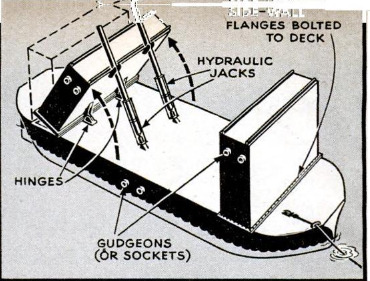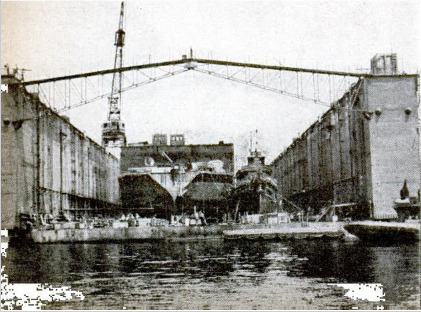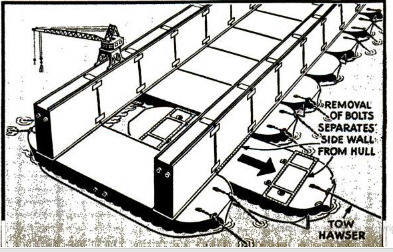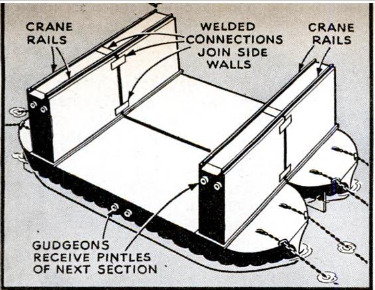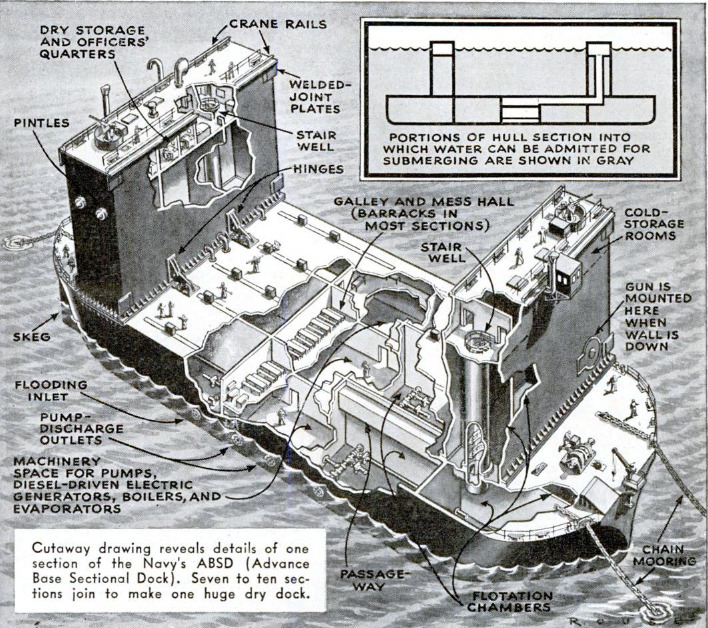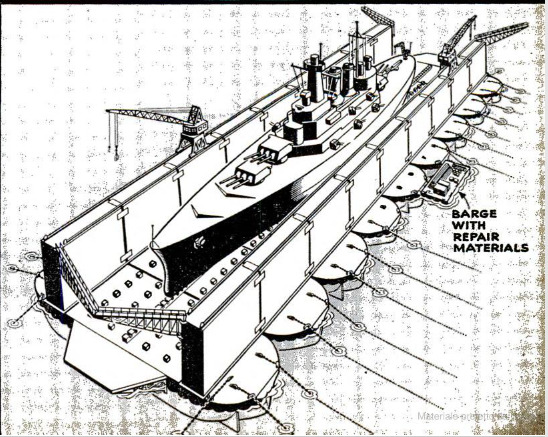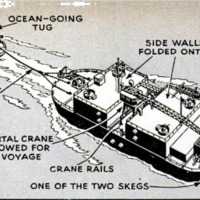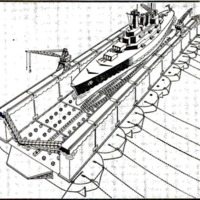-
Title (Dublin Core)
-
Seagoing navy yard follows the fleet
-
Article Title and/or Image Caption (Dublin Core)
-
Title: Seagoing navy yard follows the fleet
-
extracted text (Extract Text)
-
ANYWHERE in the seven seas, gigantic
floating dry docks take aboard the
mightiest battleships and aircraft carriers
of the United States Navy, and raise them
high and dry. When battle damage has
been repaired, the big men-of-war are re-
turned to their natural element, fit and
ready to fight again.
Having such a dock right with the fleet
when you want it fulfills an admiral’s
dream. Superdreadnoughts, in advance com-
bat areas, thus are spared voyages of
thousands of miles to permanent repair
bases at Hawaii and on the U.S. coasts.
The difference in time that the ship is out
of service may determine whether or not it
can take part in a decisive battle, and its
timely arrival could add the needed power
for victory. In fact, mobile “hospitals” for
battleships seem likely to have a profound
effect upon naval tactics of the future—a
study that no nation dares neglect, no
matter how remote the prospect of war.
First news that super dry docks were
actually completed, and operating with the
fleet, electrified naval observers many
months ago. Now that World War II has
ended, the Navy has released photographs
and a full description of these extraor-
dinary structures.
Too big to be towed safely across an
ocean in one piece, the huge dock travels in
separate sections—from seven to 10—each
built upon a boat-shaped hull. Hinged
pieces, which form the side walls of the
finished dock when elevated, are kept folded
in transit to reduce wind resistance and
lower the center of gravity.
The individual dock sections, when pre-
pared for towing, are self-contained sea-
going barges, complete with crew's quarters,
galley, mess hall, steam-heating system,
evaporators for making fresh water, Diesel-
driven alternating-current generators, cold-
storage plant, forced ventilation, anchor
winch, and antiaircraft guns. Two electric
cranes that subsequently operate on tracks
along the tops of the dock side walls are, |
during the overseas voyage, carried on rails |
laid on the main decks of two of the sections
between the lowered side walls. |
Upon arrival at the base where the dock
is to be used, the sections are temporarily
moored by their light bow anchors. The
side walls are then raised by means of
hydraulic jacking gear and bolted to bed |
plates provided on the forward and after |
deck of each section, a gasket being used in
the joint to allow for slight irregularities
in the metal. The raising of the side walls |
involves the disconnection of the engines and |
boilers from temporary exhaust lines and
stacks, which led straight up through the
lowered side walls, and their connection to |
permanent exhaust pipes and stacks termi- |
nating at the tops of the raised side walls. |
It also involves the rearrangement of offi-
cers’ quarters and storage spaces in the
side walls, as some of the Sopre of these
spaces become walls, and vice ‘versa, when
the side walls are raised.
When the side walls of two sections have
been raised, the work of connecting them is |
commenced by lashing the sections together
with the projecting pintles of one section
securely seated in matching sockets, or
gudgeons, of the other to hold the sections
in line. The lashings holding the sections
together are then supplemented by cable
linkages tightened by hydraulic jacks.
Heavy steel plates connecting the upper and
lower parts of the adjacent sections of the
side walls are then bolted into place. The
connections, after being bolted, are electri-
cally welded, the strength of the completed
connections being dependent solely on the
welds. The side walls only of the sections,
and not the hulls, are thus connected by
welding.
After two or more sections of the dock
have been connected the two big electric
cranes are transferred from the main decks
of the sections on which they made their
ocean voyage to the tracks provided for
them on the tops of the raised side walls of
the connected sections. The buoyancy
chambers of the connected sections are
flooded until the tops of their side walls are
level with the main decks of the sections
carrying the cranes. Temporary connection
of the sections and rails, as illustrated in
the drawing in the upper right-hand corner
of page 123, makes possible the transfer of
the cranes. Additional sections are then
connected until all are assembled into a
rigid, floating dry dock capable of lifting
the largest battleships and aircraft carriers.
The assembled dock is moored by heavy
anchors and chains.
A ship is lifted by first setting blocking on
the main deck of the dock to fit the keel and
bottom of the ship. The dock is then lowered
by flooding the buoyancy chambers until
only the tops of the side-wall sections pro-
trude from the water. Now the ship enters
the dock and is centered over the blocking.
Finally, the water is pumped {rom the
buoyancy chambers, causing the dock to
float and raise the ship with it.
If a hull section of the dock requires
repair, it can be withdrawn from the as-
sembly without cutting the side-wall welds,
as shown on page 122, and can then be
itself dry-docked for repair in the remaining
sections, thus making the dock completely
“gelf-docking.” To pull a section out of
place, the pintles and gudgeons are removed
from it and from the adjacent sections The
buoyancy chambers of the free section are
then partially flooded to lower the unit so
it can be eased out. The welded joints of
the side walls are strong enough to permit
the operation of the dry-dock cranes over
the missing section.
To move the dock from ome base to
another, it is disassembled by cutting the
welds. The side walls are lowered, and the
sections are towed forward and reassembled
at the new base.
The development and design of these
docks by F. R. Harris, Inc, consulting
engineers of New York City, was under the
direction of the Bureau of Yards and Docks
of the Navy Department. Their construc-
tion has materially strengthened the Pacific
Fleet, not by increasing the total number
of ships but by increasing the number of
“ships that count’—the ships available to
fight where and when fighting is to be done.
-
Contributor (Dublin Core)
-
W. Mac Angas (article writer)
Stewart Rouse (Illustrator)
-
Language (Dublin Core)
-
Eng
-
Date Issued (Dublin Core)
-
1945-11
-
pages (Bibliographic Ontology)
-
121-124
-
Rights (Dublin Core)
-
Public domain
-
Archived by (Dublin Core)
-
Sami Akbiyik
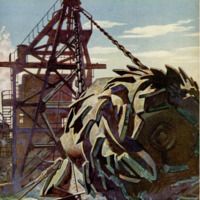 Popular Science Monthly, v. 147, n. 5, 1945
Popular Science Monthly, v. 147, n. 5, 1945


